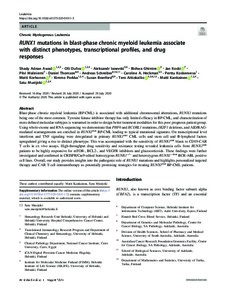RUNX1 mutations in blast-phase chronic myeloid leukemia associate with distinct phenotypes, transcriptional profiles, and drug responses
Daniel Thomson; Susan Branford; Pilvi Maliniemi; Bishwa Ghimire; Andreas Schreiber; Caroline A. Heckman; Perttu Koskenvesa; Matti Kankainen; Jan Koski; Matti Korhonen; Satu Mustjoki; Tero Aittokallio; Olli Dufva; Kimmo Porkka; Aleksandr Ianevski; Shady Adnan Awad
RUNX1 mutations in blast-phase chronic myeloid leukemia associate with distinct phenotypes, transcriptional profiles, and drug responses
Daniel Thomson
Susan Branford
Pilvi Maliniemi
Bishwa Ghimire
Andreas Schreiber
Caroline A. Heckman
Perttu Koskenvesa
Matti Kankainen
Jan Koski
Matti Korhonen
Satu Mustjoki
Tero Aittokallio
Olli Dufva
Kimmo Porkka
Aleksandr Ianevski
Shady Adnan Awad
NATURE PUBLISHING GROUP
Julkaisun pysyvä osoite on:
https://urn.fi/URN:NBN:fi-fe2021042822883
https://urn.fi/URN:NBN:fi-fe2021042822883
Tiivistelmä
Blast-phase chronic myeloid leukemia (BP-CML) is associated with additional chromosomal aberrations,RUNX1mutations being one of the most common. Tyrosine kinase inhibitor therapy has only limited efficacy in BP-CML, and characterization of more defined molecular subtypes is warranted in order to design better treatment modalities for this poor prognosis patient group. Using whole-exome and RNA sequencing we demonstrate thatPHF6andBCORL1mutations,IKZF1deletions, and AID/RAG-mediated rearrangements are enriched inRUNX1(mut)BP-CML leading to typical mutational signature. On transcriptional level interferon and TNF signaling were deregulated in primaryRUNX1(mut)CML cells and stem cell and B-lymphoid factors upregulated giving a rise to distinct phenotype. This was accompanied with the sensitivity ofRUNX1(mut)blasts to CD19-CAR T cells in ex vivo assays. High-throughput drug sensitivity and resistance testing revealed leukemia cells fromRUNX1(mut)patients to be highly responsive for mTOR-, BCL2-, and VEGFR inhibitors and glucocorticoids. These findings were further investigated and confirmed in CRISPR/Cas9-edited homozygousRUNX1(-/-)and heterozygousRUNX1(-/mut)BCR-ABL positive cell lines. Overall, our study provides insights into the pathogenic role ofRUNX1mutations and highlights personalized targeted therapy and CAR T-cell immunotherapy as potentially promising strategies for treatingRUNX1(mut)BP-CML patients.
Kokoelmat
- Rinnakkaistallenteet [19207]
